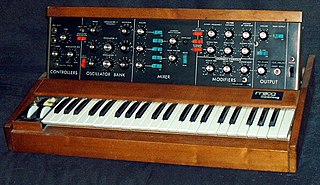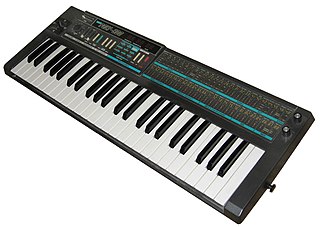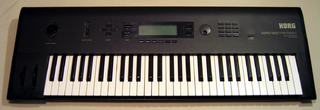Related Research Articles

A vocoder is a category of speech coding that analyzes and synthesizes the human voice signal for audio data compression, multiplexing, voice encryption or voice transformation.

Digital music technology encompasses digital instruments, computers, electronic effects units, software, or digital audio equipment by a performer, composer, sound engineer, DJ, or record producer to produce, perform or record music. The term refers to electronic devices, instruments, computer hardware, and software used in performance, playback, recording, composition, mixing, analysis, and editing of music.

An analog synthesizer is a synthesizer that uses analog circuits and analog signals to generate sound electronically.

KORG Inc., founded as Keio Electronic Laboratories, is a Japanese multinational corporation that manufactures electronic musical instruments, audio processors and guitar pedals, recording equipment, and electronic tuners. Under the Vox brand name, they also manufacture guitar amplifiers and electric guitars.
A music workstation is an electronic musical instrument providing the facilities of:

The Korg M1 is a synthesizer and music workstation manufactured by Korg from 1988 to 1995. The M1 was advertised as a 'workstation' rather than a synthesizer, integrating composition and performance features into a single device. It features 16-voice polyphony, high-quality digital samples, an integrated 8-track sequencer and digital effects processing. It is one of the bestselling synthesizers in history, selling an estimated 250,000 units.

The Korg Poly-800 is an 8-voice analog synthesizer released by Korg in 1983. Its initial list price of $795 made it the first fully programmable polyphonic synthesizer that sold for less than $1,000. It was designed for portability, featuring battery power and a lightweight design that allowed the user to play with it strapped around their neck. It utilized digitally controlled oscillators (DCOs), and was a paraphonic synth with a single filter shared between its eight voices.

Secure voice is a term in cryptography for the encryption of voice communication over a range of communication types such as radio, telephone or IP.

The microKORG is a MIDI-capable digital synthesizer/vocoder from Korg featuring DSP-based analog modelling. The synthesizer is built in such a way that it is essentially a Korg MS-2000 with a programmable step arpeggiator, a less advanced vocoder, lack of motion sequencing, lack of an XLR microphone input, and in a smaller case with fewer real-time control knobs.

The Korg MS-20 is a patchable semi-modular monophonic analog synthesizer which Korg released in 1978 and which was in production until 1983. It was part of Korg's MS series of instruments, which also included the single oscillator MS-10, the keyboardless MS-50 module, the SQ-10 sequencer, and the VC-10 Vocoder. Additional devices included the MS-01 Foot Controller, MS-02 Interface, MS-03 Signal Processor, and MS-04 Modulation Pedal.
The Korg Polysix(PS-6) is a six-voice polyphonic analog synthesizer released by Korg in 1981. It was one of the first affordable polyphonic synthesizers on the market, and was released as a cheaper alternative to the Sequential Prophet-5 and Oberheim OB-X, priced at approximately a third of the cost of its contemporaries in the polysynth market. It includes one VCO per voice, enhanced by a chorus/ensemble effect for added richness. It also comes equipped with 32 program memories and an integrated arpeggiator.

The Korg MS2000 is a virtual analog synthesizer produced by the Japanese electronic musical instrument manufacturer Korg.

The Korg Wavestation is a vector synthesis synthesizer first produced in the early 1990s and later re-released as a software synthesizer in 2004. Its primary innovation was Wave Sequencing, a method of multi-timbral sound generation in which different PCM waveform data are played successively, resulting in continuously evolving sounds. The Wavestation's "Advanced Vector Synthesis" sound architecture resembled early vector synths such as the Sequential Circuits Prophet VS.

The Korg RADIAS is a virtual analog synthesizer and Vocoder, released by Korg in 2006. The RADIAS' MMT engine was based on the Korg OASYS synthesizer module, providing for several different synthesis methods, two of which may be combined in a single voice e.g. phase distortion synthesis can be combined with subtractive synthesis. The different synthesis methods employed by MMT represent the majority of methods used historically in other Korg synthesizers: digital waveguide synthesis Korg first used in the Korg Z1 and phase distortion synthesis was first used in the Korg DS-8. This flexibility allows for very realistic emulations of past Korg synthesizers, though stays away from trying to emulate the Korg M1 and the Korg Wavestation,. As well as using the in-built waveforms for the basis of sound creation, the RADIAS allows for the input of an external signal which may be routed through the various sound shaping devices. The RADIAS has a comprehensive matrix modulation specification and to further enhance a sound the 'Wave Shaper' module allows for various sound distortion effects.

The Korg VC-10 is an analogue vocoder which Korg launched in 1978. Vocoding refers to voice encoding of speech and singing with musical synthesis. It gained popularity in the 1970s following utilisation by bands such as Kraftwerk and Electric Light Orchestra. The VC-10 allows basic functionality in operation and modulation of signal carriers. It has two microphone input options.
The Korg Collection is a suite of virtual instruments and effects that emulate Korg's various hardware synthesizers. The original release included virtual versions of the MS-20, Polysix and Wavestation. Subsequent additions have expanded the collection to feature emulations of the Mono/Poly, M1, ARP Odyssey, Triton, miniKORG 700S, Prophecy and microKORG. These plugins utilize Korg's Component Modeling Technology (CMT) to simulate the analog characteristics of the original instruments. The collection is compatible with VST, AU, and AAX plugin formats and includes standalone versions for use outside a digital audio workstation (DAW).

The DDD-1 is a sampling drum machine released by Korg in 1986. It was Korg's first drum machine equipped with MIDI control and it features 14 velocity-sensitive pads, 12-bit samples, and limited user sampling that allows for the addition of new sounds. It also offers sound expansion through ROM cards, six assignable audio outputs, and a backlit LCD display.
The Korg DRM-1 Digital Rhythm module built by Korg, in late 1987. It was introduced during 1987 Summer NAMM industry trade show in Chicago.
References
- ↑ Korg, "DWP-1 Digital Voice Processor Owner's Manual"
- ↑ Reid, Gordon (2002). "The History of Korg: Part 2", Sound on Sound (November 2002)
- ↑ Betteridge, Jim (1986). "Korg Digital Voice Processor DVP-1", International Musician & Recording World (May 1986)
- ↑ "Korg DVP-1", vintage synth explorer
- ↑ Ball, Alex (2023). "The AIR Vocoder", MATRIXSYNTH